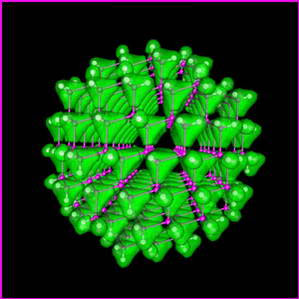 Image: Verschiedene fluoreszierende Minerale unter UV-Licht | Credit: Hannes Grobe
Image: Verschiedene fluoreszierende Minerale unter UV-Licht | Credit: Hannes Grobe
Following up on their previous quantum dot degradation study on mice, an international, interdisciplinary research team took a quantum leap into a pilot study which is said to be the first explorations into the pathologic, toxic, pharmacokinetic, and pharmacodynamic effects of cadmium-based QD formulations on non-human primates {male rhesus macaques}.
Initiated at State University of New York at Buffalo‘s Institute for Lasers, Photonics, and Biophotonics (ILPB), the transcontinental, translational studies were completed by investigative collaborators at the Nanyang Technological University in Singapore, the People’s Liberation Army General Hospital {formerly Peking Union Medical College} in China, the SUNY at Buffalo in the USA, and the ChangChun University of Science and Technology in China.
Observation of the primates was conducted at the Laboratory Animals Centre of the Chinese PLA General Hospital where the six treated adult male monkeys and one control monkey were subjected to protocols {including monitored termination of life for the purpose of ex vivo histological analysis} and reviews under the approval of PLAGH’s ethics committee.
The treated monkeys were injected with inorganic compound dispersions of Cadmium selenide / Cadmium sulfide / Zinc sulphide. Pathologists collected tissues from brain, heart, liver, spleen, lung, kidney, colon, lymph nodes, intestine, muscle, bone marrow, and skin.
ICP-MS evaluations detected concentrated levels of core constituent accumulation exceeding those of the control animal in all tissues. Analyses further revealed that an elevated level of elemental Cadmium components {more than 90%} from the initially injected CdSe/CdS/ZnS dose of nanocrystals was retained by the liver, spleen, and kidneys after the three-months interval of the year-long examination period, suggestive of aggregation and/or agglomeration. {Much lower levels were observed in the heart, lung, lymph, thymus, brain, muscle, skin, and testis}.
“The ICP-MS results strongly suggest that the quantum dot formulation is slowly degrading in the liver and spleen, releasing free cadmium ions that accumulate in the kidney. This would explain the much higher cadmium-to-selenium ratio in the kidney compared with the liver and spleen. “
{In 2011, another scientist -Dr. Diana Aga- from the same flagship SUNY campus warned about CdSe QD leaching, surface modification, soil degradation and pollution, and resultant environmental concerns due to release of toxic Cd2+ and/or Se2-/SeO32- ions. See: Differences in Soil Mobility and Degradability between Water-Dispersible CdSe and CdSe/ZnS Quantum Dots http://pubs.acs.org/doi/abs/10.1021/es201010f}.
“ Selenium uptake was also highest in the liver, spleen, and kidney but lower in the heart, lung, lymph, thymus, brain, muscle, skin, and testis. “
“ Zinc concentrations were comparable to those of the control animal, but suggested some possible accumulation in the kidney and liver. “
Biodistribution of cadmium, selenium, and zinc in this ground-breaking study on primates exhibited evidence of much higher concentrations at these sites comparative to that which was observed by Hauck et alia in rats.
Blood clearance profiles, biochemical markers, hepatic and kidney function indicators all suggested low toxicity and proved more promising.
 Image Source: Problems in Application of Quantum Dot | NanoAll blog
Image Source: Problems in Application of Quantum Dot | NanoAll blog
Exhibited evidence of elevated Ca and Se levels is cause for pause, though, in these otherwise promising results. Previous in vitro and in vivo cytotoxicity studies of cadmium-based cores such as CdTe and CdSe have already demonstrated ill effect and CdSe nanocrystals are known to be highly toxic to cultured cells under UV illumination due to photolysis, which releases toxic cadmium ions into the culture medium.
The primate investigators’ ultimate quest is towards toxicologic and pathogenic reduction resulting from the heavy-metal ion leaching, the success of which could mean, in turn and in time, that the ideal upconversion luminescence (UCL) benefits of nanocrystals which better enable longer-term photostability outcomes in in vivo imaging and dynamics studies and the high-precision aspects of QD-based devices could both be eventually exploited for human clinical use in biomedical applications such as tumour identification and removal, vascular tissue imaging, targeted drug delivery, photodynamic theragnostics, drug discovery, interventional radiology, and mapping.
Included in the two lead researchers’ and their co-author’s monitoring results and cautionary conclusions of this pioneering primate nanopathology study is a warning as to the indications and well-known risks of cadmium accumulation. Their caution calls for further examination and determinate studies on the fate, persistence, metabolism, excretion, stability, and immune response in relation to QD size, charge, concentration, surface coating bioactivity, and stability are absolutely required before these formulations can be approved and their potential promise fully realized. Their cautionary conclusions prudently advise that the most suitable in vivo approach with hope of approval for the CaSe nanocrystals would be development towards single-dose applications such as in real-time image-guided surgery {IGS}.
{ Results of the trail-blazing work can be readily accessed here: http://www.natureasia.com/en/research/index/highlight/id/1819/ http://www.nature.com/nnano/journal/vaop/ncurrent/full/nnano.2012.74.html }
 Image: Nature China | Nature Asia-Pacific Research Science & Clinical Medicine Highlights
Image: Nature China | Nature Asia-Pacific Research Science & Clinical Medicine Highlights
But even such limited-capacity cadmium-based utilization will not meet approval in some regions, given that Cadmium is known to be a carcinogenic substance and an aquatic toxin. Supply and use of the element is prohibitively restricted in some instances and altogether banned in certain consumer goods in Europe, for example, under REACH {Registration, Evaluation, Authorisation, and Restriction of CHemicals) regulation by a Restriction of Hazardous Substances {RoHS} directive:
http://europa.eu/rapid/pressReleasesAction.do?reference=IP/11/620
Cadmium-free quantum dots {CFQD} and other heavy metal-free QDs possessing similar optical properties to those used in the primate study have been developed as alternatives. Luminescence excitation mechanisms of rare earth {RE} doped NPs comprise alternates to the toxic CaSe nanocrystals. Among the advantages of the cadmium-free nanotechnologies are aqueous-based synthesis {which obviates water solubility issues for biological applications} and oxide surfacing which allows for easier chemical functionalization and stability in varying environments.
COMPARATIVES ARE PROVIDED BELOW:
http://www.nanomaterialstore.com/nano-phosphor.php
http://www.nanocotechnologies.com/content/CommercialApplications/Biological.aspx
Comments